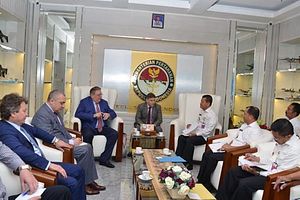As Indonesia modernizes its military, one of the key focus areas has been upgrading the country’s fighter aircraft, following a series of problems including the grounding of existing jets (See: “Between Aspiration and Reality: Indonesian Foreign Policy After the 2014 Election”).
Several potential candidates had been considered, one of which was the Sukhoi Su-35 from Russia, which is currently Indonesia’s largest military supplier. In September 2015, Indonesia’s then-defense minister Ryamizard Ryacudu announced that Indonesia had made a decision to buy the Russian aircraft, with talks beginning in November to discuss details of the deal.
But since then, details of the allegedly impending deal have repeatedly changed, with few signs of a final deal materializing anytime soon even as other alternatives, including the JAS 39 Gripen from Sweden and the F-16 Block 60 Viper from the United States, continue to remain on the horizon (See: “What Does Indonesia’s New Air Force Pick Mean?”). And as of now, there appear to be few signs of this changing anytime soon.
Last week, a Russian delegation visited the Indonesian defense ministry (Kemhan), with a view to discuss the status of ongoing defense projects between the two countries. The delegation consisted of a mix of Russian officials and defense representatives, including the Russian defense attache to Indonesia and individuals from Rostec and Rosoboronexport, the Russian state arms export agency.
During the meeting, which took place on May 3, the Russian delegation brought up the status of the Sukhoi Su-35 fighter jets, indicating that though it has passed several stages, it is still being held up. According to the Indonesian defense ministry, the official response from its secretary general, Vice Admiral Widodo, was that there was still the need for an evaluation from the ministry’s procurement team, which is still determining provisions, said to include defense offset obligations as well as others such as trade and funding. It added that the MoD’s procurement team is still “waiting for certainty” from the trade ministry regarding trade and technology transfer.
These concerns are not new for close observers of Indonesian military affairs. Technology transfer, for instance, has long been a sticking point for Indonesia in its dealings with Russia and also in the evolution of some of its other defense relationships, with Jakarta seeking greater access to technology as it seeks to build up its own domestic defense industry (See: “An Indonesian Defense Revolution Under Jokowi?”).
In addition, in truth such technical issues are also only one part of an often complex story than tends to characterize big-ticket Indonesian defense acquisitions, which are in turn tied to the broader structural and institutional challenges that the country’s military modernization faces as well as the choices that it ultimately makes (See: “Can Indonesia Speed Up Its Military Aircraft Modernization?”).
Widodo did add that he hoped that “all related parties will be able to help this project to be realized soon.” But the meeting clearly illustrated that despite Russia’s enthusiasm about finalizing the deal, resolving the challenges that remain will not be as easy as the occasional headlines about an impending sale suggest.































